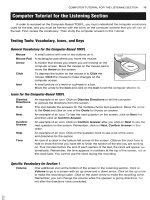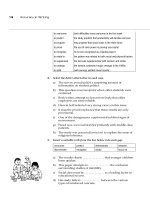Chapter 117. Health Advice for International Travel (Part 9) pptx
Bạn đang xem bản rút gọn của tài liệu. Xem và tải ngay bản đầy đủ của tài liệu tại đây (26.21 KB, 10 trang )
Chapter 117. Health Advice for
International Travel
(Part 9)
Fever
Fever in a traveler who has returned from a malarious area should be
considered a medical emergency because death from P. falciparum malaria can
follow an illness of only several days' duration. Although "fever from the tropics"
does not always have a tropical cause, malaria should be the first diagnosis
considered. The risk of P. falciparum malaria is highest among travelers returning
from Africa or Oceania and among those who become symptomatic within the
first 2 months after return. Other important causes of fever after travel include
viral hepatitis (hepatitis A and E), typhoid fever, bacterial enteritis, arboviral
infections (e.g., dengue fever), rickettsial infections (including tick and scrub
typhus and Q fever), and—in rare instances—leptospirosis, acute HIV infection,
and amebic liver abscess. A cooperative study by GeoSentinel (an emerging
infectious disease surveillance group established by the CDC and the International
Society of Travel Medicine) showed that, among 3907 febrile returned travelers,
malaria was acquired most often from Africa, dengue from Southeast Asia and the
Caribbean, typhoid fever from southern Asia, and rickettsial infections (tick
typhus) from southern Africa (Table 117-3). In at least 25% of cases, no etiology
can be found, and the illness resolves spontaneously. Clinicians should keep in
mind that no present-day antimalarial agent guarantees protection from malaria
and that some immunizations (notably, that against typhoid fever) are only
partially protective.
Table 117-
3 Etiology and Geographic Distribution (Percent) of
Systemic Febrile Illness in Returned Travelers (N = 3907)
Etiology Car
ib
CA
m
SA
m
SS
A
S
CA
SE
A
Malaria <1 13 13
62
14
13
Dengue 23 12 14
<1
14
32
Mononucle
osis
7 7 8 1 2 3
Rickettsia 0 0 0 6
1 2
Salmonella
2 3 2 <1
14
3
Note: Carib, Caribbean; CAm, Central America; SAm, South America;
SSA, Sub-Saharan Africa; SCA, South Central Asia; SEA, Southeast Asia. Bold
type is for emphasis only.
Source: Revised from Table 2 in Freedman et al, 2006. Used with
permission from the Massachusetts Medical Society.
When no specific diagnosis is forthcoming, the following investigations,
where applicable, are suggested: complete blood count, liver function tests,
thick/thin blood films for malaria (repeated twice if necessary), urinalysis, urine
and blood cultures (repeated once), chest x-ray, and collection of an acute-phase
serum sample to be held for subsequent examination along with a paired
convalescent-phase serum sample.
Skin Diseases
Pyodermas, sunburn, insect bites, skin ulcers, and cutaneous larva migrans
are the most common skin conditions affecting travelers after their return home. In
those with persistent skin ulcers, a diagnosis of cutaneous leishmaniasis,
mycobacterial infection, or fungal infection should be considered. Careful,
complete inspection of the skin is important in detecting the rickettsial eschar in a
febrile patient or the central breathing hole in a "boil" due to myiasis.
Emerging Infectious Diseases
In recent years, travel and commerce have fostered the worldwide spread of
HIV infection, led to the reemergence of cholera as a global health threat, and
created considerable fear about the possible spread of severe acute respiratory
syndrome (SARS) and avian influenza (H5N1). For travelers, there are more
realistic concerns. One of the largest outbreaks of dengue fever ever documented
is now raging in Latin America; schistosomiasis is being described in previously
unaffected lakes in Africa; and antibiotic-resistant strains of sexually transmitted
and enteric pathogens are emerging at an alarming rate in the developing world. In
addition, concerns have been raised about the potential for bioterrorism involving
not only standard strains of unusual agents but mutant strains as well. Time will
tell whether travelers (as well as persons at home) will routinely be vaccinated
against diseases such as anthrax and smallpox. As Nobel laureate Dr. Joshua
Lederberg pointed out, "The microbe that felled one child in a distant continent
yesterday can reach yours today and seed a global pandemic tomorrow." The
vigilant clinician understands that the importance of a thorough travel history
cannot be overemphasized.
Further Readings
Chen LH,
Keystone JS: New strategies for the prevention of malaria in
travelers. Infect Dis Clin North Am 19:185, 2005 [PMID: 16027794]
DuPont AW, DuPont HL: Travelers' diarrhea: Modern concepts and new
developments. Curr Treat Options Gastroenterol 9:13, 2006 [PMID: 16423310]
Freedman DO et al (GeoSentinel Surveillance Network): Spectrum of
disease and relation to place of exposure among ill returned travelers. N Engl J
Med 354:119, 2006 [PMID: 16407507]
Keystone JS et al: Travel Medicine. Mosby, Philadelphia, 2004
Okhuysen PC: Current concepts in travelers' diarrhea: Epidemiology,
antimicrobial resistance and treatment. Curr Opin Infect Dis 18:522, 2005 [PMID:
16258326]
Ryan ET et al: Illness after international travel. N Engl J Med 347:505,
2002 [PMID: 12181406]
Shlim DR: Update in traveler's diarrhea. Infect Dis Clin North Am 19:137,
2005 [PMID: 15701551]
Sohail MR, Fischer PR: Health risks to air travelers. Infect Dis Clin North
Am 19:67, 2005 [PMID: 15701547]
Wilson ME, Chen LH: Dermatologic infe
ctious diseases in international
travelers. Curr Infect Dis Rep 6:54, 2004 [PMID: 14733850]
Websites of Interest: Chronic renal failure: www.kidney.org
. Diabetes:
www.diabetesmonitor.com/other-14.htm. Dialysis: www.dialysisfinder.com
.
Disability: www.access-able.com. HIV: www.aegis.com
Bibliography
Angell SY, Behrens RH: Risk assessment and disease prevention in
travelers visiting friends and relatives. Infect Dis Clin North Am 19:49, 2005
[PMID: 15701546]
Caumes E et al: Dermatoses associated with travel to tropical countries: A
prospective
study of the diagnosis and management of 269 patients presenting to a
tropical disease unit. Clin Infect Dis 20:542, 1995 [PMID: 7756473]
Centers for Disease Control and Prevention:
Health Information for
International Travel 2005–2006. HHS publication no (CDC) 92-
8280.
Washington, DC, Government Printing Office, 2005
(
Connor BA:
Sequelae of traveler's diarrhea: Focus on postinfectious
irritable bowel syndrome. Clin Infect Dis 41(Suppl 8):S577, 2005
Dondorp AM et al: Fake antimalarials in Southeast Asia are a major
impediment to malaria control: Multinational cross-se
ctional survey on the
prevalence of fake antimalarials. Trop Med Int Health 9:1241, 2004 [PMID:
15598255]
Fradin MS, Day JF: Comparative efficacy of insect repellents against
mosquito bites. N Engl J Med 347:13, 2002 [PMID: 12097535]
Furrer H et al: Increased risk of wasting syndrome in HIV-
infected
travellers: Prospective multicentre study. Trans R Soc Trop Med Hyg 95:484,
2001 [PMID: 11706654]
Gerard L et al: Rifaximin: A nonabsorbable rifamycin antibiotic for use in
nonsystemic gastrointestinal inf
ections. Expert Rev Anti Infect Ther 3:201, 2005
[PMID: 15918778]
Keystone JS et al: Internet and computer-
based resources for travel
medicine practitioners. Clin Infect Dis 32:757, 2001 [PMID: 11229844]
———: GIDEON computer program for diagnosing and
teaching
geographic medicine. J Travel Med 6:152, 1999
Khoo S et al: The potential for interactions between antimalarial and
antiretroviral drugs. AIDS 19:995, 2005 [PMID: 15958830]
Magill AJ: Fever in the returned traveler. Infect Dis Clin North Am 12
:455,
1998
Mileno MD, Bia FJ: The compromised traveler. Infect Dis Clin North Am
12:369, 1998 [PMID: 9658250]
Shanks GD, Edstein MD: Modern malaria chemoprophylaxis. Drugs
65:2091, 2005 [PMID: 16225366]
Shlim DR: Looking for evidence that personal hy
giene precautions prevent
traveler's diarrhea. Clin Infect Dis 41(Suppl 8):S531, 2005
Shulman CE, Dorman EK: Importance and prevention of malaria in
pregnancy. Trans R Soc Trop Med Hyg 97:30, 2003 [PMID: 12886801]
Spira A: Assessment of travellers who
return home ill. Lancet 361:1459,
2003 [PMID: 12727414]
———: Preparing the traveller. Lancet 361:1368, 2003
Wilson ME, Kain KC:
Health advice and immunizations for travelers. N
Engl J Med 342:1716, 2000
——— et al: Infections in HIV-infected travelers
: Risks and prevention.
Ann Intern Med 114:582, 1991









